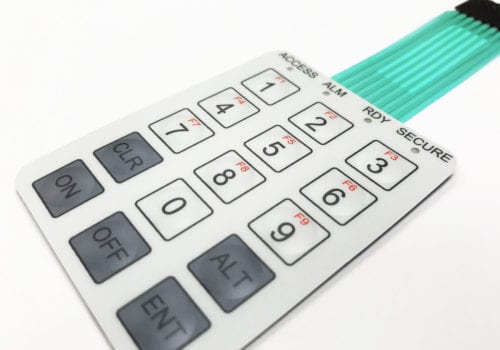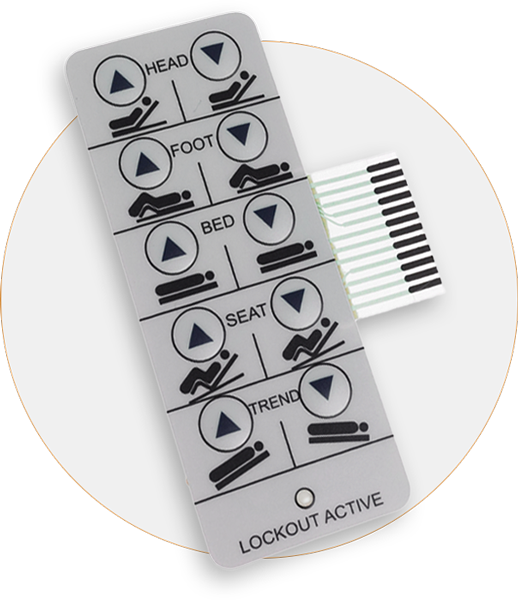The Major Benefits of Using Membrane Switches in Commercial Uses
The Major Benefits of Using Membrane Switches in Commercial Uses
Blog Article
Membrane Switch Innovation: The Secret to Reliable and Affordable Interfaces
Membrane switch modern technology has arised as a crucial part in the style of individual interfaces, offering both dependability and cost-effectiveness across a varied variety of applications. As we check out the multifaceted benefits of membrane layer buttons, their possibility for technology increases concerns about future applications and evolving fads.
Recognizing Membrane Layer Switch Technology
Membrane layer switch technology is a widely made use of interface solution in numerous digital devices, offering a seamless blend of capability and style. This technology includes several layers of materials, usually being composed of a graphic overlay, spacer layer, and a circuit layer. The visuals overlay presents the user interface components, while the spacer layer separates the circuit layer from the overlay till a customer triggers a switch.
When stress is put on the overlay, the circuit layer finishes the electric circuit, sending a signal to the device. This mechanism permits different setups, consisting of responsive comments and backlighting choices, boosting user communication. Membrane buttons are usually manufactured making use of resilient products such as polyester or polycarbonate, guaranteeing long life and resistance to environmental variables like moisture and dirt.
The versatility of membrane layer switches enables their application in varied industries, consisting of clinical devices, customer electronics, and commercial controls. Their compact style enables combination right into space-constrained environments, supplying a reliable interface without jeopardizing visual appeal. Comprehending the intricacies of membrane button technology is important for suppliers and designers looking for to produce dependable and reliable human-machine interfaces.
Key Benefits of Membrane Buttons
While numerous user interface solutions exist, membrane switches offer unique benefits that make them a recommended choice in various applications. One of the key benefits is their toughness; membrane switches are made to endure rough ecological conditions, including wetness, dirt, and temperature level fluctuations, making sure durable efficiency. This resilience substantially lowers the demand for frequent replacements, thus reducing total upkeep prices.

Additionally, membrane buttons are light-weight and small, making them suitable for applications where room is restricted. Their low-profile design adds to a smooth appearance without compromising functionality.
Cost-effectiveness is likewise a noteworthy advantage, as the production process for membrane switches over has a tendency to be more economical contrasted to conventional mechanical switches. This price, integrated with their reliability and simplicity of installation, placements membrane switches over as a functional service for a variety of industries looking for efficient and efficient user interfaces.
Applications Throughout Various Industries
Exactly how do membrane layer switches adapt to the diverse demands of numerous industries? Membrane switch innovation is significantly acknowledged for its flexibility, making it appropriate for a vast range of applications across multiple markets.
In customer electronic devices, membrane layer buttons provide a compact service for push-button controls and home devices, boosting individual experience via instinctive design. Additionally, the commercial market leverages membrane layer buttons for machinery control board, benefiting from their resistance to severe settings, such as wetness and dust.
Armed forces and aerospace applications also use membrane layer switches for their dependability and capability to withstand severe problems, making certain operational efficiency in crucial situations. The food and drink sector takes on these switches for automated systems, where hygiene and convenience of operation are paramount (membrane switch). Ultimately, membrane switches are customized to satisfy the distinct demands of each sector, verifying their vital duty in modern technology user interfaces
Design and Modification Alternatives

In the world of membrane layer button innovation, style and modification alternatives play a critical function in boosting capability and customer communication. These switches can be tailored to satisfy specific operational demands and aesthetic choices, making them functional elements in different applications.
One of the key customization over here alternatives is the format of the button itself, which can be created to suit special interface and ergonomic factors to consider. By readjusting the form, dimension, and setup of switches, suppliers can create intuitive styles that help with ease of usage. Furthermore, the incorporation of various colors and graphic overlays permits branding and improved presence, making certain that users can rapidly identify functions.
Moreover, membrane buttons can be engineered with different tactile responses devices, such as elevated buttons or audible clicks, to enhance the customer experience. Various materials can likewise be picked for toughness and environmental resistance, resolving aspects such as wetness, temperature level fluctuations, and chemical direct exposure.
Ultimately, the substantial design and modification alternatives readily available in membrane layer button innovation encourage companies to develop customized services that not link just fulfill functional needs however additionally line up with their branding and functional needs.

Future Patterns in Membrane Layer Switches
As membrane directory layer switch modern technology remains to progress, future patterns are increasingly concentrated on enhancing individual experience and integrating advanced performances. One substantial trend is the assimilation of touch-sensitive and capacitive innovations into typical membrane buttons. This growth enables more user-friendly user interfaces, offering responsive feedback while maintaining a streamlined style.
One more arising fad is the usage of eco-friendly products, driven by the expanding need for sustainable manufacturing practices. Makers are seeking to minimize their carbon footprint by utilizing recyclable substratums and low-impact inks, lining up with worldwide sustainability goals.
In addition, the surge of the Net of Points (IoT) is motivating the incorporation of smart functions right into membrane switches. Enhanced connection options will make it possible for devices to interact with each other, permitting smooth assimilation right into wider systems.
In addition, innovations in printing technologies, such as electronic printing, are permitting better style versatility and personalization. This enables producers to produce elaborate layouts and vivid colors cost-effectively.

Final Thought
In conclusion, membrane layer button modern technology stands for a crucial development in customer interface design, using substantial advantages in toughness, modification, and cost-effectiveness. As innovations continue to emerge, particularly in touch-sensitive user interfaces and sustainable products, the capacity for membrane switches to enhance individual experience and capability stays encouraging.
Report this page